MARIANI’SVirtual Gourmet
July 1, 2012
NEWSLETTER
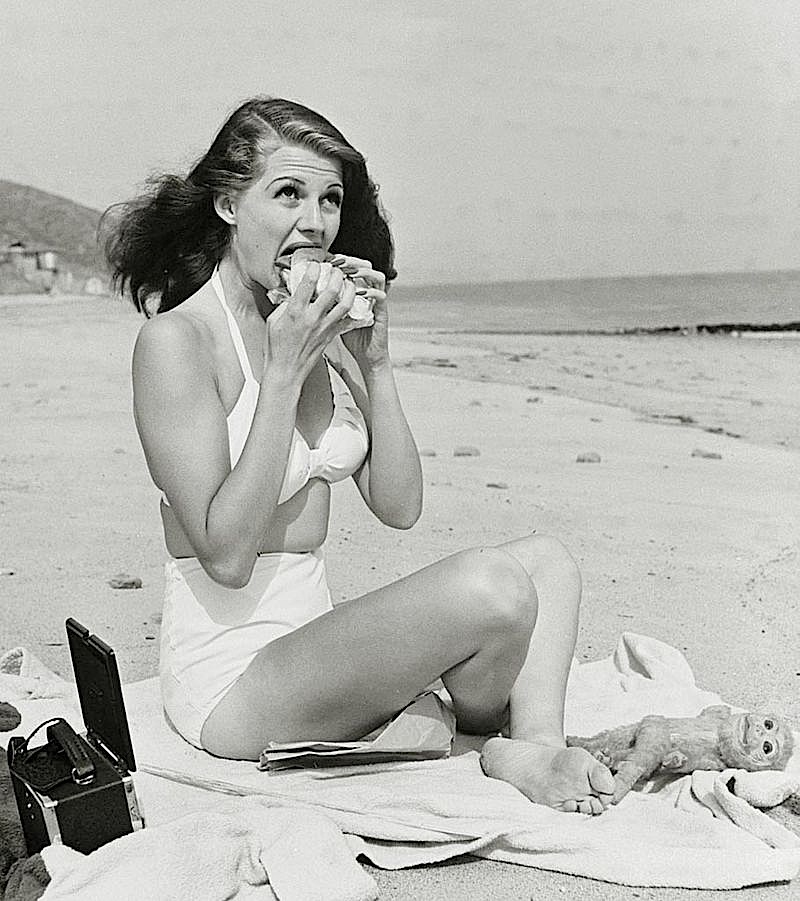
Rita Hayworth, 1947
HAPPY 4TH OF JULY!
❖❖❖
THIS WEEK
THE ROAD TO MOROCCO
PART
TWO
by
John Mariani
NEW YORK CORNER
GEM
by John
Mariani
NOTES FROM THE WINE CELLAR
The Wines of Morocco
by John Mariani
❖❖❖
THE ROAD TO MOROCCO
PART
TWO
by
John Mariani
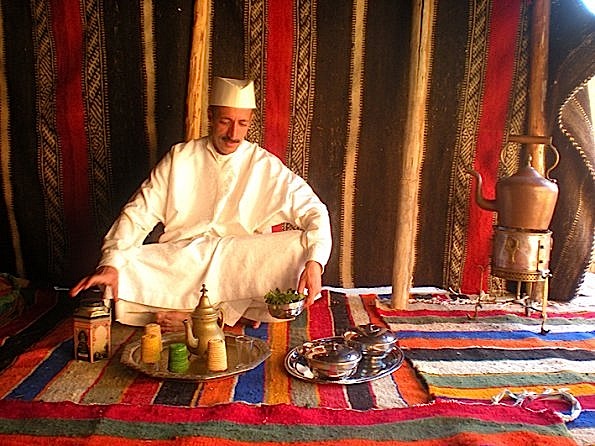
Hotel Atlas Kasbah
Before
heading to Marrakech, we left Agadir and drove
into the Atlas Mountains, where, this being February,
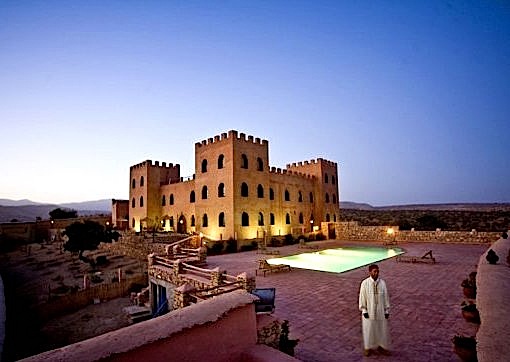 the temperature dropped in the evening
to one requiring sweaters and coats. Winding our
way up through through the area called Tighanimine
Elbaz, we arrived at a unique hilltop inn, run by
Hassan and Helene Aboutayeb, a Berber and his French
wife, both of whom hold a Master's degree in
Sustainable Development. This was Hotel
Atlas Kasbah (right),
a nine-room Ecolodge that opened in 2009, located in
the Unesco World Heritage Site called the Argan
Biosphere, an area readily visited for its flora and
fauna, with the lodge as a home base. Helene is one of
the most enchanting guides and authorities to
everything in the region, and she will happily arrange
for tours and reservations, make recommendations and
explain the cooking at her inn. They also have a quiet
lounging room (actually, everything here is blissfully
quiet) where you sit on pillows, read, have tea or
watch a movie, including "Casablanca." This is a
very special place.
the temperature dropped in the evening
to one requiring sweaters and coats. Winding our
way up through through the area called Tighanimine
Elbaz, we arrived at a unique hilltop inn, run by
Hassan and Helene Aboutayeb, a Berber and his French
wife, both of whom hold a Master's degree in
Sustainable Development. This was Hotel
Atlas Kasbah (right),
a nine-room Ecolodge that opened in 2009, located in
the Unesco World Heritage Site called the Argan
Biosphere, an area readily visited for its flora and
fauna, with the lodge as a home base. Helene is one of
the most enchanting guides and authorities to
everything in the region, and she will happily arrange
for tours and reservations, make recommendations and
explain the cooking at her inn. They also have a quiet
lounging room (actually, everything here is blissfully
quiet) where you sit on pillows, read, have tea or
watch a movie, including "Casablanca." This is a
very special place.
 There is a pool here on the
rooftop, overlooking the mountains and valley, and
everything at the lodge is designed with ecology in
mind, including 80 percent of the electrical energy
derived from the sun. In winter this arrangement
with nature can make the rooms pretty cold, even with
space heaters in place, and I slept under several
blankets that night, awakening to a world warming up
minute by minute in the brilliant desert
sunshine. We went down for a splendid breakfast
of irresistible breads (below), eggs, barley broth,
argan oil, and little tagine ceramics of condiments,
and herbal teas. Dinner that night at the lodge
consisted of a delicious tabooleh with mint, a chicken tagine with
caramelized onions galore, and fresh strawberries to
finish. The menu changes almost every night,
There is a pool here on the
rooftop, overlooking the mountains and valley, and
everything at the lodge is designed with ecology in
mind, including 80 percent of the electrical energy
derived from the sun. In winter this arrangement
with nature can make the rooms pretty cold, even with
space heaters in place, and I slept under several
blankets that night, awakening to a world warming up
minute by minute in the brilliant desert
sunshine. We went down for a splendid breakfast
of irresistible breads (below), eggs, barley broth,
argan oil, and little tagine ceramics of condiments,
and herbal teas. Dinner that night at the lodge
consisted of a delicious tabooleh with mint, a chicken tagine with
caramelized onions galore, and fresh strawberries to
finish. The menu changes almost every night,  and cooking lessons are
offered here. One advisory: the lodge does not have a
wine or liquor license, so you might want to buy some
wine or beer before arriving.
and cooking lessons are
offered here. One advisory: the lodge does not have a
wine or liquor license, so you might want to buy some
wine or beer before arriving.
The road out of
the Valley to Marrakech winds through the desert, gray
at dawn, the color of a roan horse at midday, and then
the land gets hilly, spotted with shrubs and desert
flowers, with mountains in the distance that might
make you think of Arizona. And as the miles roll by
the farms appear, the land greener. Mile by mile the
villages get larger, more people are on the side of
the roads, vegetable stands appear, and you can see
the road widen and shimmer with mirages of
water.
 Far off, then closer and
closer, are squat houses and minarets, and planted
palm trees appear, and then, not suddenly, you start
to see broad, new avenues, white apartment buildings,
and ancient walls. Your arrival in Marrakech, called
the Ocher City for its color, is signaled by milling
masses of people in the outer squares festooned with
goods for sale, and the broad Avenue Mohammed VI
winds into the city center, where the traffic picks
up, the mosques come into view, and the eyes of the
people on the road regard your passage. You
drive through the Jardin des Jeunes, and then the vast
city of a million people engages your attention for
its historic cast and its low stature, for no building
may be built higher than a mosque,
Far off, then closer and
closer, are squat houses and minarets, and planted
palm trees appear, and then, not suddenly, you start
to see broad, new avenues, white apartment buildings,
and ancient walls. Your arrival in Marrakech, called
the Ocher City for its color, is signaled by milling
masses of people in the outer squares festooned with
goods for sale, and the broad Avenue Mohammed VI
winds into the city center, where the traffic picks
up, the mosques come into view, and the eyes of the
people on the road regard your passage. You
drive through the Jardin des Jeunes, and then the vast
city of a million people engages your attention for
its historic cast and its low stature, for no building
may be built higher than a mosque,
It needs to said right away of the Moroccans, and especially those in Marrakech, that they are extremely friendly and welcoming to foreigners, and despite a minority of Muslims bent on changing their country to Fundamentalism, Morocco has been one of the most peaceful countries throughout the Arab world. Morocco is a country of commerce, and profitable commerce effectively blunts unprofitable antagonisms that have elsewhere come to a boiling point. The government is a constitutional monarchy, and King Mohammud VI has been viewed by most as a tolerant liberal in a country with 50 years of independence behind it.
We drove up
to our hotel, the storied La
Mamounia, opened in 1923, the greatest of all
caravansaries and one of the grandest hotels in the
world. Indeed, three hotels this year have stood out
in my travels as among the very finest I’ve ever
stayed at: one is Glenmere
Mansion in New York’s Hudson Valley, the other I
will tell you about in a few weeks. La Mamounia is of
a caliber of fineness you find at the George V in
Paris, the Hassler in Rome, the Dorchester in London.
(Incidentally, no NYC, Chicago, Los Angeles, or San
Francisco hotel would rank as high in my estimation.)
A truly great hotel, for me, is not just one of unique
design, impeccable service, and modern amenities, but
one that is expressive of the spirit and vitality of a
city, without a chain mentality driven by management.
The hotel was a
favorite of Winston Churchill, after whom the bar here
is named, and the entire property underwent a complete
update by designer Jacques Garcia in 2009 that has
resulted 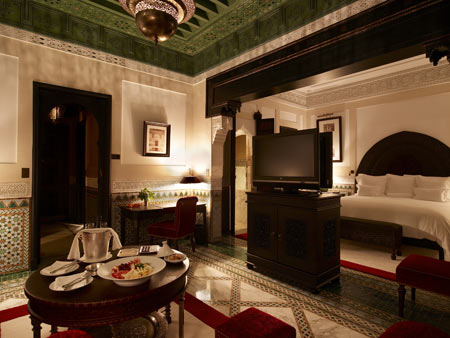 in public and private spaces
of gorgeously lighted beauty, shadowy, flickering,
shimmering with gold leaf, shiny with marble, and
draped with silks and satins. There are 136 guest
rooms, 71 suites, and three riads of three bedrooms, salons,
private terrace and ozone swimming pool. There
is also a 27,000
square-foot Mamounia Spa, where I had my first
cleansing and relaxing hamman experience, a
state-of-the-art fitness center, and tennis courts,
even a ‘Boulodrome’ for games of la pétanque.
in public and private spaces
of gorgeously lighted beauty, shadowy, flickering,
shimmering with gold leaf, shiny with marble, and
draped with silks and satins. There are 136 guest
rooms, 71 suites, and three riads of three bedrooms, salons,
private terrace and ozone swimming pool. There
is also a 27,000
square-foot Mamounia Spa, where I had my first
cleansing and relaxing hamman experience, a
state-of-the-art fitness center, and tennis courts,
even a ‘Boulodrome’ for games of la pétanque.
You are cordially greeted at the doorman by name and given dates to eat (there are 30 varieties in Morocco) and rosewater milk as a refreshment before being shown around the hotel by lovely young women dressed in white, past sunlit atriums with designer boutiques, and into the landscaped green gardens past the glowing pool, beside which you may take your extensive buffet breakfast.
My suite, which
looked out on the gardens and city, was sumptuously
decorated, the fabrics and linens of the finest
quality, pillows overstuffed, with as much artistry in
the wall finishings and moldings as in the carpets and
furniture. Sweet pastries and fruit were set on the
table and replenished during my stay.
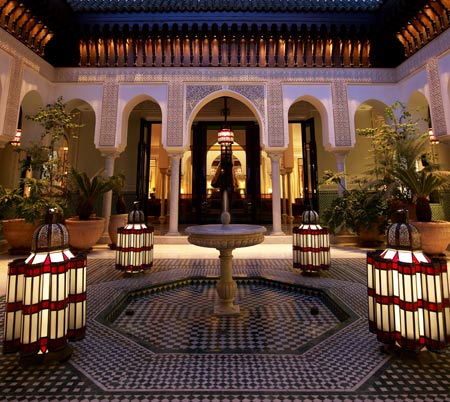 There are five bars and
three restaurants, headed by Executive Chef Fabrice
Lasnon, and chefs Alfonso Iaccarino and Jean-Pierre
Vigato, all with
Gallic-sounding names--Le Marocain, Le
Français, L’Italien, and, by the pool, Le
Pavillon de la Piscine. Attached to the Italian
restaurant is a swank bar and lounge that is full each
night with people having cocktails as they might have
in 1930s British movies, and a French restaurant as
luxurious as any in Paris but lighter in its color and
ambiance. We dined at Le Français and were
impressed with the quality of the ingredients, as many
as possible local, but, since Europe is just across
the Mediterranean, whatever needs to be brought in
will be the best available, along with an excellent
wine list with several Moroccan wines (see my article
below. Service throughout is as attentive
as you'd wish.
There are five bars and
three restaurants, headed by Executive Chef Fabrice
Lasnon, and chefs Alfonso Iaccarino and Jean-Pierre
Vigato, all with
Gallic-sounding names--Le Marocain, Le
Français, L’Italien, and, by the pool, Le
Pavillon de la Piscine. Attached to the Italian
restaurant is a swank bar and lounge that is full each
night with people having cocktails as they might have
in 1930s British movies, and a French restaurant as
luxurious as any in Paris but lighter in its color and
ambiance. We dined at Le Français and were
impressed with the quality of the ingredients, as many
as possible local, but, since Europe is just across
the Mediterranean, whatever needs to be brought in
will be the best available, along with an excellent
wine list with several Moroccan wines (see my article
below. Service throughout is as attentive
as you'd wish.
There is a great
deal to see in Marrakech, a city that developed
from Berber encampments in the 11th century, though
museums are not among its more intriguing attractions.
This is an imperial city, and an important stop
is the Bahia Palace and Saadian tombs, where the
former rulers of the Saad dynasty are buried in
subdued splendor.  There is also a large, rambling Garden
called the Jardins
Majorelle, which has been restored by Pierre
Bergé and the late Yves Saint Laurent, where
you'll also find Majorelle's Berber Museum of more
than 600 art objects of jewelry, leather, weapons, and
woven textiles.
There is also a large, rambling Garden
called the Jardins
Majorelle, which has been restored by Pierre
Bergé and the late Yves Saint Laurent, where
you'll also find Majorelle's Berber Museum of more
than 600 art objects of jewelry, leather, weapons, and
woven textiles.
The most vibrant
and fascinating of all places in Marrakech is the
Djemaa El Fina, the Main Square (right), where all
of the city’s street life swirls around you, including
fruit merchants, souvenir vendors, food tents and a
few snake charmers who are always happy to drape one
over your shoulder (try to avoid the cobras). From the
square you enter the Berber souk market, which itself
winds like a serpent through corridors crammed with
every imaginable item, from silks and shoes to food
and medicines. What I found most interesting about the
experience of walking through this market is the low
level of hustling, owing to a royal dictate that
merchants tone their appeals down with tourists who don’t
like be hassled step by step. This makes the route far
more appealing than you would find in a bazaar in,
say, Istanbul, where you are assaulted by merchants
calling out to you in whatever language you speak. You
can spend hours here, and it’s a good idea to leave at
twilight when the gas lamps come on and the pace of
everything slows and people leave work just to walk
and buy in the Square.
with tourists who don’t
like be hassled step by step. This makes the route far
more appealing than you would find in a bazaar in,
say, Istanbul, where you are assaulted by merchants
calling out to you in whatever language you speak. You
can spend hours here, and it’s a good idea to leave at
twilight when the gas lamps come on and the pace of
everything slows and people leave work just to walk
and buy in the Square.
Having eaten so
much seafood in the restaurants in the coastal cities
leading up to our arrival in Marrakech, I was ravenous
to try the specialties for which Moroccan cuisine is
known--the tagines,
couscous, and
pastillas that are native here. For our
first lunch in town, we went to a well-known place run
entirely by women, called Al Fassia Gueliez (left), at 55
Boulevard Zerktouni, considered by many local
gastronomes to serve some of the best traditional
Moroccan food in the city, set within a sunny enclosed
terrace that is charming at lunchtime. The breads are
addictive, and we ordered a pastilla of squab, with wonderfully
crisp pastry; a tagine
of chicken with abundant sweet onions and tangy
preserved lemon; and a lamb couscous that also
included chicken on a base of steamy millet, laced
with hot harissa.
For dessert there was a delightful couscous called seffa, made with
milk, cinnamon, and honey, and a pastilla of
crushed almonds and honey served with a ladle of warm
milk. (Incidentally, there is another restaurant
in the city, attached to a hotel, named Al
Fassia, but they are not connected.)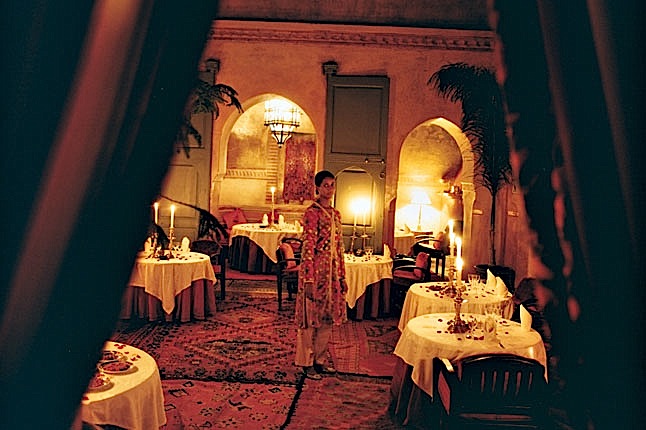
Le
Tobsil (right)
is a must-go place (it gets a big tourist crowd, but
then so do all the better known restaurants in
Marrakech), not only for its food but for the
bewildering route you must take within the medina to
reach it, hidden down a labyrinth of shadowy streets.
Fortunately a restaurant guide in a fez will bring you
to it, a door on a narrow street that opens to a
two-story restaurant run by a Frenchwoman named
Christine Rio and Moroccan chef Fatima Mountassarim.
In its décor and architecture, beautiful rugs
and tablesettings this is very evocative of old
Marrakech, low lighted, with a duo of musicians whose
droning plays continuously throughout the night.
(Obviously these are not union musicians.) 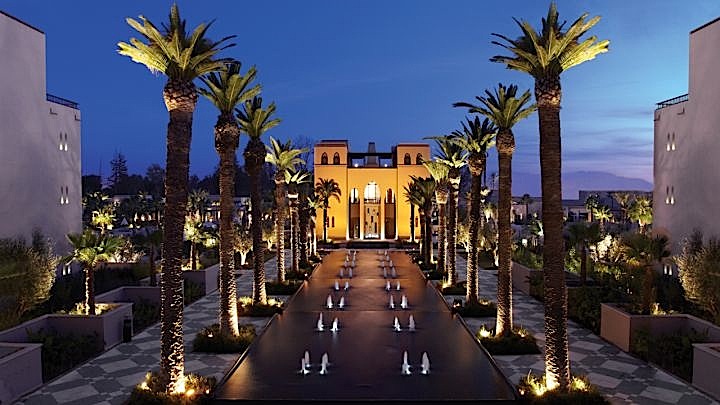 You half expect Sidney
Greenstreet in a white suit and fez to be sitting
across from you negotiating exit visas.
You half expect Sidney
Greenstreet in a white suit and fez to be sitting
across from you negotiating exit visas.
In he candlelit room, you begin here with
an array of mezes,
nearly a dozen salads and condiments--tomatoes,
sausages, purees--followed by a lavish couscous and
tagine, then dessert. The fixed price dinner includes
Moroccan wines.
We had toured Morocco's western coast, along the Mediterranean and down the Atlantic, which gave us only one side of the country's character and history. The other lay in far into the desert, in tented accommodations, with different food and different culture. And that will be my next visit to a land that evokes all the images western art has itself tried to evoke crafted in pages and picture frames, but that also reveals a deeper, exotic spirit within its cities, in its deserts, and all along its seaside. Morocco, ancient and modern, is a country that others in northern Africa might well emulate.
❖❖❖
NEW
YORK CORNER
by John Mariani
Gem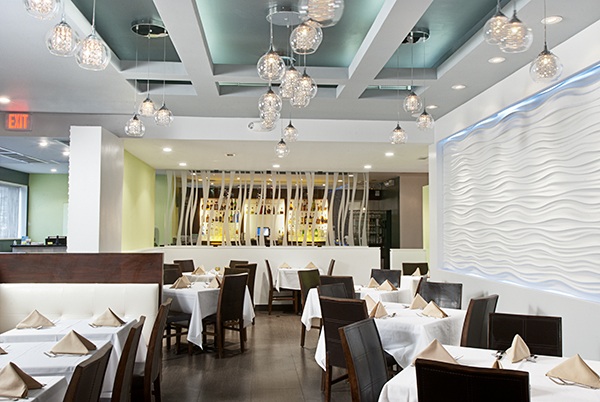
1828
Central Park Avenue
Yonkers, NY
914-361-1500
gemchineserestaurant.com
More
than 30 years ago Paul Chou opened a restaurant in
Yonkers, NY (40 minutes from midtown Manhattan, 15
from the George Washington Bridge) called Hunan
Village, which at the time was exemplary for serving
the kind of hot, spicy Chinese regional food that had
become so popular, and ubiquitous, in the 1970s. It
was certainly the best of its kind in Westchester
County, and key to its success was Mr. Chou himself,
whose presence made every guest a friend after one
visit and whose suggestions on what was special to eat
on any given evening were taken by all who became
regulars--many of whom call him by the honorific Uncle
Paul--interested in true Chinese cuisine.
Over the next 20
years Hunan Village did well, changed décor,
introduced a wider range of dishes, and then, after a
bit of a health scare, Mr. Chou retired and leased the
restaurant to someone else, who pretty much squandered
all the good will he had worked so hard to build. Back
to peak health, Mr. Chou decided, almost on a whim
last year, to give the business another try, but not
simply to update Hunan Village. He had been traveling
extensively in China for years and collected ideas and
recipes that would find their way onto his new menus
at his new restaurant, Gem--as appropriate a name as I
can think of for a Chinese restaurant of this caliber.
In fact, after years when Chinese restaurants dotted
the long stretch of Central Avenue from Yonkers to
White Plains, Gem is one of very few left, really a
gem in a wilderness of mediocre chain
restaurants.
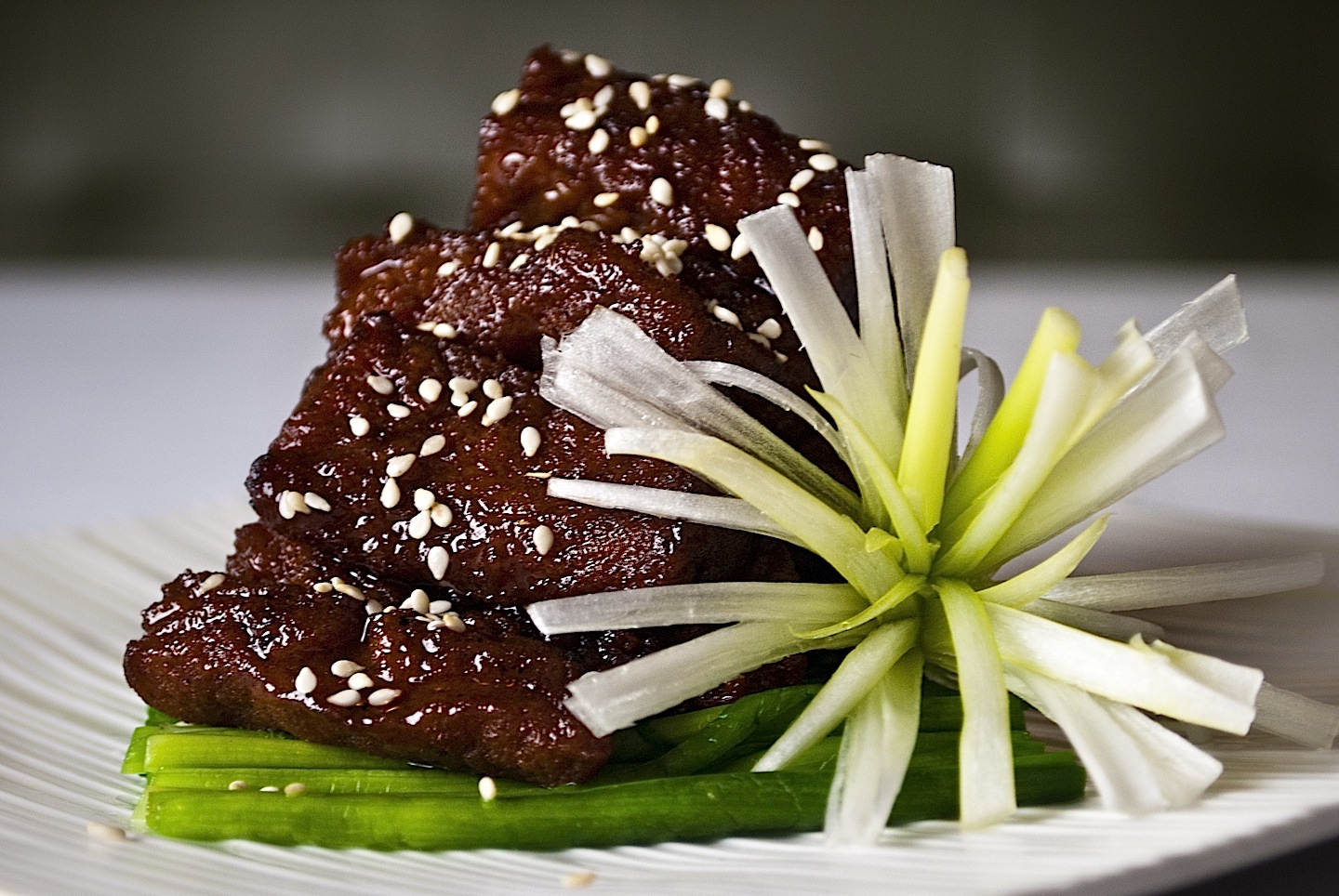 Decorously, Gem could not be more
different from the red-and gold interior of old Hunan
Village. Now the rooms are done in a clean, modern
style you’d find in an upscale restaurant in Taipei or
Hong Kong, with cool colors of white, gray, celadon,
and dark wood. A rippling wall of white
resembles snow or sand trails. You immediately sense
this is not a place you drop into for moo shu pork and
beef with orange sauce. Still, many of the true
classics of Chinese cuisine, with a stronger nod to
the more delicate cooking on Canton and the
seafood of Shanghai, are here, all artfully presented
in the modern style rather than just ladled onto an
oval dish.
Decorously, Gem could not be more
different from the red-and gold interior of old Hunan
Village. Now the rooms are done in a clean, modern
style you’d find in an upscale restaurant in Taipei or
Hong Kong, with cool colors of white, gray, celadon,
and dark wood. A rippling wall of white
resembles snow or sand trails. You immediately sense
this is not a place you drop into for moo shu pork and
beef with orange sauce. Still, many of the true
classics of Chinese cuisine, with a stronger nod to
the more delicate cooking on Canton and the
seafood of Shanghai, are here, all artfully presented
in the modern style rather than just ladled onto an
oval dish.
The sharpened
menu reveals the intent here, but the specials of the
evening are the key to understanding what Mr. Chou and
his chef Pu are seeking to do, which is to educate the
American palate. Better yet, choose among those
items listed as "Paul's Recommendations"; best of all,
just put 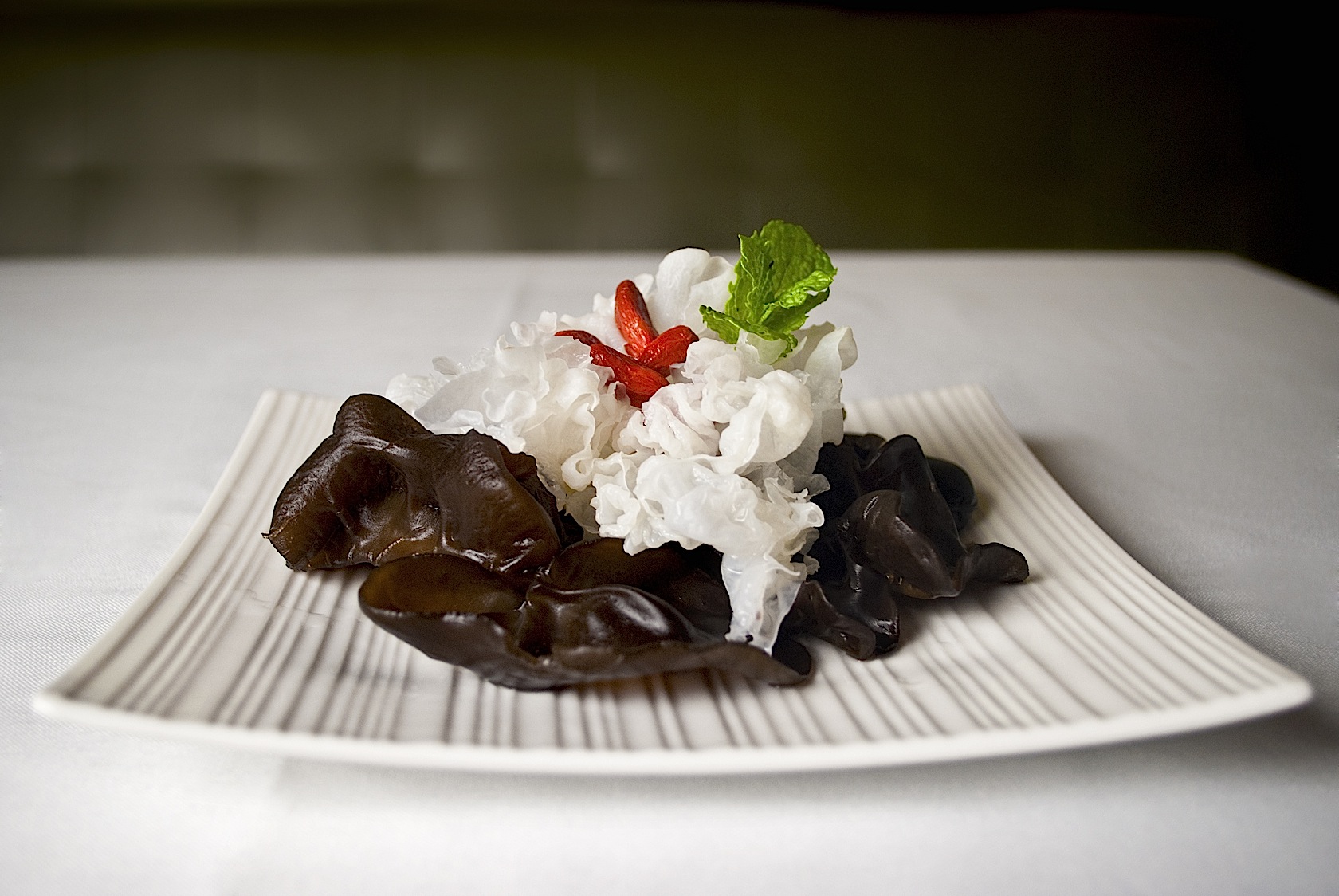 yourself in his hands, and you will be
treated to dishes of great taste and beauty. By
all means order the Beijing crispy
lamb (above)
with sesame seeds, set atop asparagus, and
glistening in its marinade. For starters have
the gargantuan Sichuan piquant shrimp, which indeed
they are, their tails in the air, on sliced
cucumbers and chile peppers. Or try the rice cake
with dried seaweed, the winter melon pickled in
tangerine juice, or the white mountain yam with
blueberry puree.
yourself in his hands, and you will be
treated to dishes of great taste and beauty. By
all means order the Beijing crispy
lamb (above)
with sesame seeds, set atop asparagus, and
glistening in its marinade. For starters have
the gargantuan Sichuan piquant shrimp, which indeed
they are, their tails in the air, on sliced
cucumbers and chile peppers. Or try the rice cake
with dried seaweed, the winter melon pickled in
tangerine juice, or the white mountain yam with
blueberry puree.
It would be easy to go vegetarian
here and be enchanted with a dish like the
cylinders of pressed spinach (below),
with curlicues of pepper and saluting chilies, set
on a glaze of tangy mustard sauce.
Gem's beautifully presented black stone wood ear
mushrooms and grey sole, looking like a fluffed
handkerchief, with green peppercorns (right) is a
tour de force of delicacy. Chicken
is served with pretty green garlic stems, and
eggplants are seasoned with cumin and sprinkled with
scallions.
Just about anywhere on the menu
you'll find dazzling displays--French-cut rack of
lamb marinated and grilled with steamed sausage;
"Tingling pepper chicken" that will lead to a
tingling pepper palate; baby ginger duck sliced thin
and irresistibly flavored with ginger, green cabbage
and white radish; crispy fish
of the day comes with garlic-infused tofu. And
the delicate Shanghai soup dumplings here are among
the best I've had this side of the
Pacific. 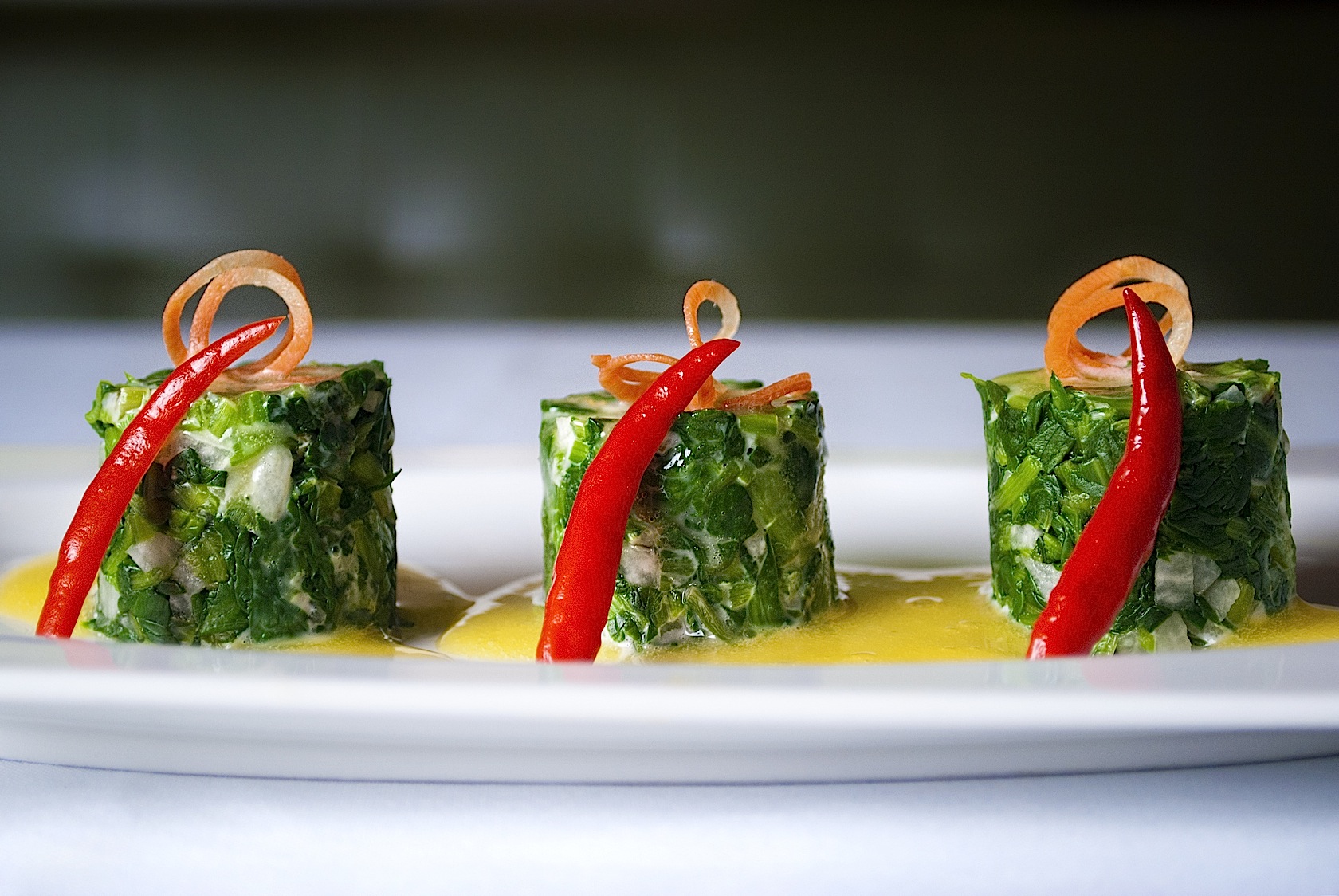 You can also
order Beijing duck any night of the week, and an old
favorite, Sichuan dried shredded beef, has never
been better.
You can also
order Beijing duck any night of the week, and an old
favorite, Sichuan dried shredded beef, has never
been better.
One of the
big problems with restaurants in America's
Chinatowns is that non-Chinese diners usually
get very different food, even wholly different
menus, than do their Chinese customers. I know,
because I've dined in Chinatown with Paul Chou, who
completely discarded the printed menus because he
knew what the chef's signature dishes really
were. So, too, while the American guests who
want some of the old-fashioned Chinese dishes
they've always loved, Gem will happily serve
them. But for a true aficionado of exquisite
Chinese cuisine, Gem will reward you with a rich
array of dishes you won't find anywhere else, making
this a worthwhile trip from anywhere in the Tristate
area.
You need not ask for Paul: He
will be there at the front door to greet you and
then to guide you once you sit down. Paul Chou is Gem.
Gem's
appetizers run $3-$14, main courses $14-$32. Open
for lunch and daily daily.
❖❖❖
by John Mariani
Moroccan
Wines Survive Desert Winds, Heat and Religious
Prohibition
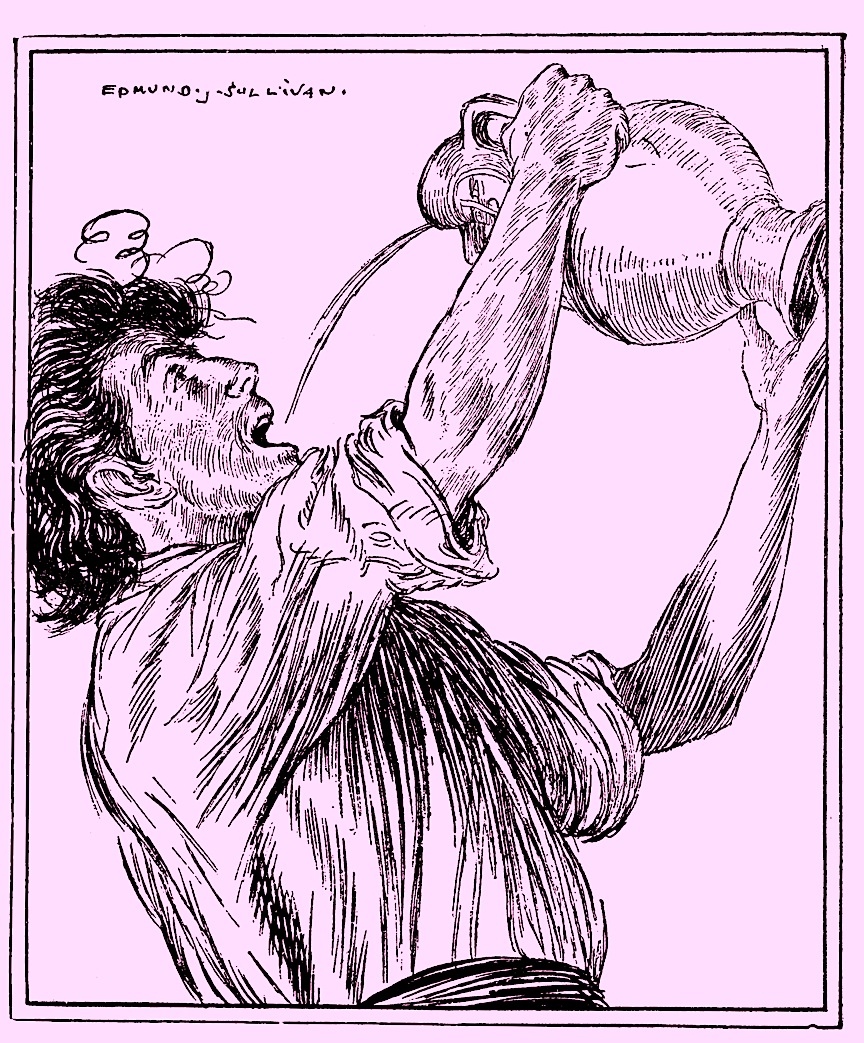
Edmund J. Sullivan,
"Rubaiyat of Omar Khayyam"
It’s easy enough
to say “When in Rome drink as the Romans do,” but
what’s a wine lover to do in Marrakech?
For starters, Morocco
is predominantly Islamic, a religion that forbids
drinking alcohol (oddly enough, the word “alcohol”
derives from the Pre-Islamic Arabic word “al-kohl”) but
not its production, historically overseen by
Christians and Jews. When Morocco became a
protectorate of France in 1912, the French found
fertile soil, especially in the Meknes region of the
Middle Atlas Mountains, in which to build a
formidable wine industry. By the time of Morocco’s
independence in 1956, 55,000 hectares (135,850
acres) were under cultivation. 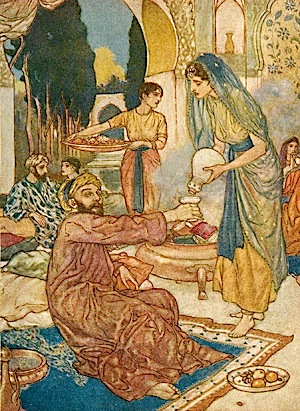
But with France’s departure from
Morocco, vineyards grew fallow; in 1967 the EEC (now
the EU) froze most Moroccan wines out of the global
market. What vineyards remained were under strict
government control. But at the urging of King Hassan
II and Mohammed VI in the 1990s, French wine
companies returned to lease vineyards and replant
with European varietals. By the beginning of this
century, 50,000 hectares were again under
cultivation. This, and the influx of tourism, has
made the sale of alcohol and wine widespread in
Morocco’s major cities, although in many areas it is
still forbidden, especially during Muslim holy days.
So, on a recent trip to
Morocco, I found little problem ordering beer, wine,
or martinis at hotels and restaurants, including
those run by Muslims. Frankly, I
didn’t expect any of it to be all that good, and my
first few bottles of merely pleasant white wines
were much enhanced by drinking them with gloriously
fresh seafood at open-air French brasseries along
the Mediterranean coast in cities like Casablanca,
Safi, and Essaouira.
It wasn’t till I got to Marrakech, where
well-spiced meat-based dishes like couscous and tagines
demanded a hearty red wine, that I began to be
impressed, especially after a tasting with Manuel
Schott (below),
the Alsatian-born sommelier in the wine cellar at La
Mamounia Hotel, which stocks more than two dozen
Moroccan wines, out of 400 labels on the list. “One
of the problems in Morocco is that, after April, it
is so hot,” said Schott, “so that just shipping the
wines can compromise them. I ask for the wines to be
delivered either in early morning or after 7 PM. In August
and September the desert winds are so harsh that
they can destroy 30 to 40 percent of the harvest.”
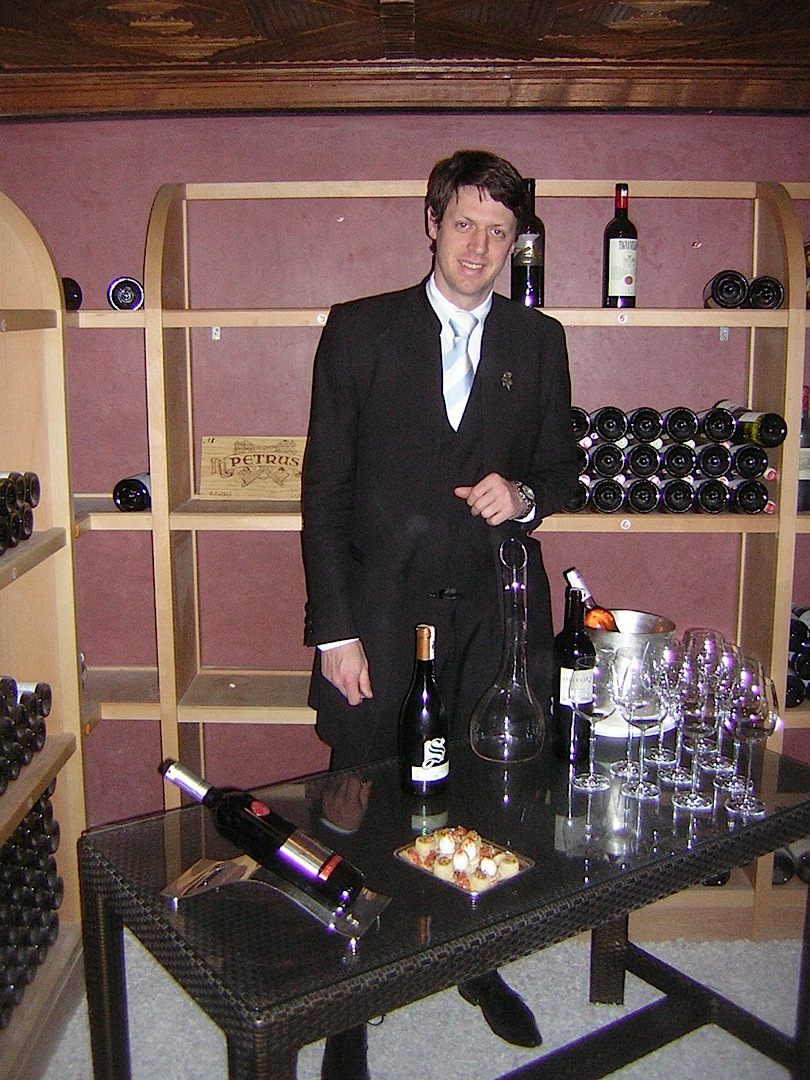 Most
of the new wineries are French owned, including a
delicious wine, El Mogador Gris, made in Provence
Essaouira by a vigneron from the Rhone Valley named
Charles Melia. El Mogador is Morocco’s first organic
winery. It
is called “Gris” (gray, in French) because it is a
color between white and rose, and it was very fresh
and well made, at 12.5 percent alcohol, with a
lingering flavor and aroma of raspberries. Even more
enticing was a blend of 80 percent chardonnay and 20
percent viognier, at 13 percent alcohol, called
Odyssee La Ferme Rouge. This was a very lush wine
whose rich chardonnay flavor took on the spicy scent
of the viognier in impressive balance.
Most
of the new wineries are French owned, including a
delicious wine, El Mogador Gris, made in Provence
Essaouira by a vigneron from the Rhone Valley named
Charles Melia. El Mogador is Morocco’s first organic
winery. It
is called “Gris” (gray, in French) because it is a
color between white and rose, and it was very fresh
and well made, at 12.5 percent alcohol, with a
lingering flavor and aroma of raspberries. Even more
enticing was a blend of 80 percent chardonnay and 20
percent viognier, at 13 percent alcohol, called
Odyssee La Ferme Rouge. This was a very lush wine
whose rich chardonnay flavor took on the spicy scent
of the viognier in impressive balance.
S de Siroua by Domaine des Ouled
Thaleb in the Rommani region, is 100 percent
chardonnay, with a bold 14 percent alcohol and a
full body from aging in new barriques that give it a
vanilla caramel undertone.
Volubilia 2008 was 100 percent
cabernet sauvignon, a varietal that can take some
heat, and it showed well at a moderate 13.5 percent
alcohol, with good tannins and acid. Its relative
lightness derived from its spending no time in oak
barrel at all.
Schott says that at least 60
percent of La Mamounia’s guests order Moroccan
wines, which would have been a rare thing even a
decade ago. Wise
investment and a more progressive attitude towards
alcohol have quickly improved the wines, which, if
difficult to find abroad, are well worth drinking
when in Marrakech.
John Mariani's wine column appears in Bloomberg
Muse News, from which this story was adapted.
Bloomberg News covers Culture from art, books, and
theater to wine, travel, and food on a daily basis.
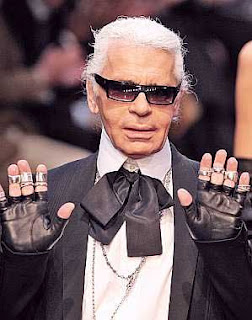
As he does everywhere, at the launch of his exhibition
“The Little Black Jacket” at the Swiss Institute,
designer Karl Lagerfeld (right) required a butler from
the catering company Olivier Cheng
to follow him around at
parties with a goblet of Pepsi Max on a silver tray.
. . . Meanwhile designer
Phillipe 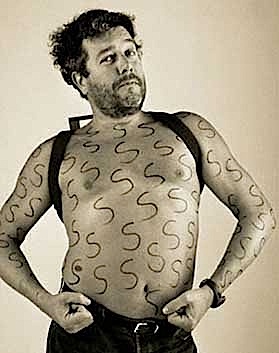 Starck
(left) and
scientist David Edwards have come out with an alcohol spray
called Wahh Quantum Sensations--.075 milliliters
of alcohol per dose,
said to get you momentarily drunk with no side
effects. It
is currently only available in Europe where a
21-shot cans costs 20 euro (US$26).
Starck
(left) and
scientist David Edwards have come out with an alcohol spray
called Wahh Quantum Sensations--.075 milliliters
of alcohol per dose,
said to get you momentarily drunk with no side
effects. It
is currently only available in Europe where a
21-shot cans costs 20 euro (US$26).
HIGH ON A
HILL, IT CALLS TO ME….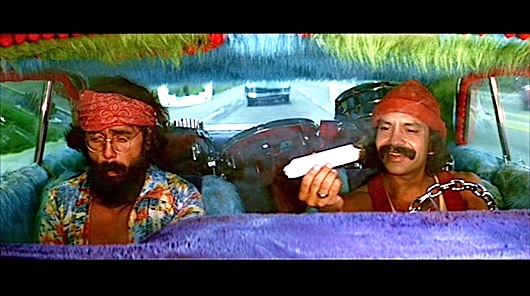
"`What are these called again?' I asked, scooping up a
second mouthful of gravy-, chili paste-, and
mayonnaise-drenched fries. `Gamja fries,' said our
server. `It's like ganja but with an M.' We shoveled
another forkful. `They were a big hit on 4/20,' she
deadpanned, referring to the recent marijuana
legalization activities."
--Jay
Barmann, "Namu
Gaji: Reincarnation Fits Nicely into New Mission
Home," SF
WEEKLY .
Any of John Mariani's
books below may be ordered from amazon.com.
 |
My latest book, which just won the prize for best book from International Gourmand, written with Jim Heimann and Steven Heller, Menu Design in America, 1850-1985 (Taschen Books), has just appeared, with nearly 1,000 beautiful, historic, hilarious, sometimes shocking menus dating back to before the Civil War and going through the Gilded Age, the Jazz Age, the Depression, the nightclub era of the 1930s and 1940s, the Space Age era, and the age when menus were a form of advertising in innovative explosions of color and modern design. The book is a chronicle of changing tastes and mores and says as much about America as about its food and drink.
“Luxuriating vicariously in the pleasures of this book. . . you can’t help but become hungry. . .for the food of course, but also for something more: the bygone days of our country’s splendidly rich and complex past. Epicureans of both good food and artful design will do well to make it their coffee table’s main course.”—Chip Kidd, Wall Street Journal.
“[The menus] reflect the amazing craftsmanship that many restaurants applied to their bills of fare, and suggest that today’s restaurateurs could learn a lot from their predecessors.”—Rebecca Marx, The Village Voice. |
"Eating Italian will never be the same after reading John Mariani's entertaining and savory gastronomical history of the cuisine of Italy and how it won over appetites worldwide. . . . This book is such a tasteful narrative that it will literally make you hungry for Italian food and arouse your appetite for gastronomical history."--Don Oldenburg, USA Today. "Italian
restaurants--some good, some glitzy--far
outnumber their French rivals. Many of
these establishments are zestfully described
in How Italian Food Conquered the World, an
entertaining and fact-filled chronicle by
food-and-wine correspondent John F.
Mariani."--Aram Bakshian Jr., Wall Street
Journal.
"Equal parts
history, sociology, gastronomy, and just
plain fun, How Italian Food Conquered the
World tells the captivating and delicious
story of the (let's face it) everybody's
favorite cuisine with clarity, verve and
more than one surprise."--Colman Andrews,
editorial director of The Daily
Meal.com. "A fantastic and fascinating
read, covering everything from the influence
of Venice's spice trade to the impact of
Italian immigrants in America and the
evolution of alta cucina. This book will
serve as a terrific resource to anyone
interested in the real story of Italian
food."--Mary Ann Esposito, host of PBS-TV's
Ciao
Italia. "John Mariani has written the
definitive history of how Italians won their
way into our hearts, minds, and
stomachs. It's a story of pleasure over
pomp and taste over technique."--Danny Meyer,
owner of NYC restaurants Union Square Cafe,
Gotham Bar & Grill, The Modern, and
Maialino.
|
 |
 |
 |
 |
 |
 |
 |
 |
❖❖❖
 Everett Potter's Travel Report:
Everett Potter's Travel Report: 
 Eating Las Vegas
is the new on-line site for Virtual Gourmet
contributor John A. Curtas., who since 1995
has been commenting on the Las Vegas food
scene and reviewing restaurants for Nevada
Public Radio. He is also the
restaurant critic for KLAS TV, Channel 8 in
Las Vegas, and his past reviews can be
accessed at KNPR.org.
Click on the logo below to go directly to
his site.
Eating Las Vegas
is the new on-line site for Virtual Gourmet
contributor John A. Curtas., who since 1995
has been commenting on the Las Vegas food
scene and reviewing restaurants for Nevada
Public Radio. He is also the
restaurant critic for KLAS TV, Channel 8 in
Las Vegas, and his past reviews can be
accessed at KNPR.org.
Click on the logo below to go directly to
his site.

Tennis Resorts Online: A Critical Guide to the World's Best Tennis Resorts and Tennis Camps, published by ROGER COX, who has spent more than two decades writing about tennis travel, including a 17-year stretch for Tennis magazine. He has also written for Arthur Frommer's Budget Travel, New York Magazine, Travel & Leisure, Esquire, Money, USTA Magazine, Men's Journal, and The Robb Report. He has authored two books-The World's Best Tennis Vacations (Stephen Greene Press/Viking Penguin, 1990) and The Best Places to Stay in the Rockies (Houghton Mifflin, 1992 & 1994), and the Melbourne (Australia) chapter to the Wall Street Journal Business Guide to Cities of the Pacific Rim (Fodor's Travel Guides, 1991).


MARIANI'S VIRTUAL GOURMET
NEWSLETTER is published weekly. Editor/Publisher: John
Mariani.
Contributing Writers: Christopher Mariani, Robert Mariani,
John A. Curtas, Edward Brivio, Mort Hochstein,
Suzanne Wright, and Brian Freedman. Contributing
Photographers: Galina Stepanoff-Dargery,
Bobby Pirillo. Technical Advisor: Gerry McLoughlin.
© copyright John Mariani 2012
